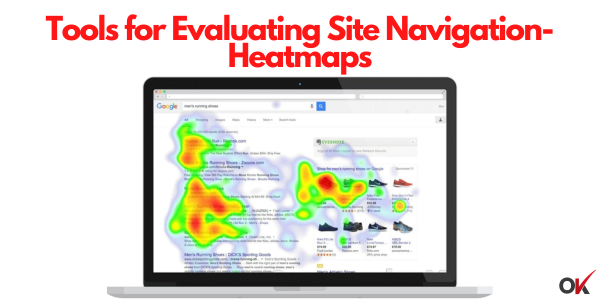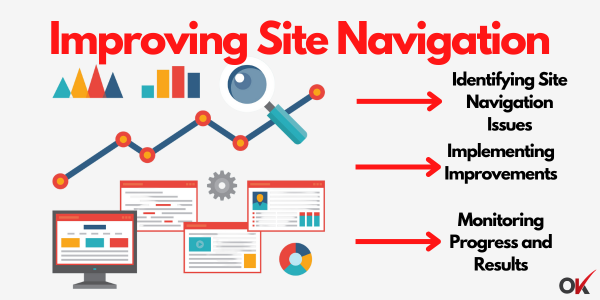You will be learning what is the important role of site navigation for a website, and how a properly crafted navigation could improve your website’s SEO dramatically.
- Effective site navigation improves SEO by enhancing user experience and search engine crawling.
- Usability, accessibility, and consistency are key principles for successful site navigation.
- Poor navigation leads to high bounce rates, shorter dwell times, and lower conversion rates, negatively impacting SEO.
- Best practices for Malaysian businesses include localization, mobile-friendly design, clear labels, and intuitive organization.
- Tools like Google Analytics and user feedback help evaluate and improve site navigation, while SEO service providers offer expert assistance.
Table of Contents

Introduction
The Significance of SEO in the Digital Landscape
In today’s highly competitive online marketplace, having a strong presence on search engines like Google is essential for businesses to succeed. Search Engine Optimization (SEO) is a crucial strategy to achieve better visibility and attract potential customers. With businesses in Malaysia increasingly adopting digital platforms, effective SEO has become even more crucial for growth and success.
The Malaysian Business Context and Online Presence
As Malaysia’s digital landscape rapidly evolves, businesses must stay ahead of the curve to remain competitive. With a diverse population and growing internet penetration, Malaysian businesses must cater to various languages and cultural preferences in their online presence. This is where an SEO Expert Agency like OKTIMIZE can help businesses excel in the digital space.
Overview of Site Navigation and Its Relevance to SEO
Site navigation is vital in SEO because it affects user experience, engagement, and search engine crawling. A well-structured and user-friendly website can significantly improve search engine rankings and help businesses drive more traffic and conversions. This article will explore the importance of site navigation in SEO services for Malaysian businesses and provide practical insights to optimize your website’s navigation.
Part 1: Understanding the Role of Site Navigation
What is Site Navigation?

Definition and Components
Site navigation is the system that allows users to navigate through a website, finding the information they need with ease. It includes various components such as menus, links, buttons, and breadcrumbs that guide users through the site’s pages and content.
Types of Site Navigation
There are several types of site navigation, including:
- Main navigation: This is the primary menu displayed on the website, usually placed at the top or side of the page. It contains links to the most critical sections of the site.
- Footer navigation: This is a secondary menu at the bottom of the page, providing additional links to less critical pages or sections.
- Breadcrumbs: These links show the user’s path through the site, allowing them to retrace their steps or return to higher-level pages quickly.
- In-page navigation: This includes links within the content of a page, guiding users to related or supplementary information.
Principles of Effective Site Navigation
Effective site navigation is built on three fundamental principles:
- Usability: Users should be able to understand and use the navigation system with minimal effort. This includes clear labels, logical organization, and appropriate visual cues.
- Accessibility: Navigation should be accessible to all users, including those with disabilities or using assistive technologies.
- Consistency: Consistent navigation elements and structure across the site ensure a smooth and coherent user experience.
Part 2: Site Navigation and SEO
The Relationship Between Site Navigation and SEO
Search Engine Crawling and Indexing
A well-structured site navigation system enables search engine crawlers to explore and index a website’s content efficiently. This helps search engines understand the site’s architecture, relevance, and quality, leading to higher rankings in search results.
User Experience and Engagement
A user-friendly navigation system contributes to a positive user experience, encouraging visitors to stay longer, explore more pages, and engage with the content. This can increase social sharing, repeat visits, and search engine rankings.
How Site Navigation Affects SEO Performance
Bounce Rate
Poor site navigation can cause users to leave a website without engaging with the content, resulting in a high bounce rate. Search engines may interpret a high bounce rate as a sign of low-quality content, negatively affecting the site’s rankings.
Dwell Time
A well-organized navigation system encourages users to explore a website more, increasing the average dwell time. Search engines perceive longer dwell times as an indicator of valuable content, which can positively impact search rankings.
Conversion Rate
Effective site navigation guides users toward desired actions like purchasing, signing up for a newsletter, or contacting the business. This leads to a higher conversion rate, which is beneficial for the business and signals to search engines that the website provides a satisfactory user experience.
Part 3: Site Navigation Best Practices for Malaysian Businesses
Localization and Language Support
Multilingual Support (English, Malay, Chinese, Tamil)
Malaysia is a multilingual country with diverse linguistic preferences. Providing site navigation in multiple languages, including English, Malay, Chinese, and Tamil, is essential to catering to this diverse audience. This ensures a better user experience for all visitors and can improve search engine rankings.
Cultural Considerations
Understanding and respecting the cultural nuances of the Malaysian market is crucial when designing site navigation. This includes using culturally appropriate images, icons, and language to create a more engaging and relatable experience for local users.
Mobile-friendly Navigation
Responsive Design
With most internet users accessing websites through mobile devices, it is vital to have a responsive design that adapts to different screen sizes and orientations. This ensures seamless navigation and improves the user experience, boosting SEO performance.
Touchscreen Optimization
Optimizing navigation for touchscreen devices involves using larger buttons, adequate spacing, and easily accessible menus. This enables users to interact with the site on mobile devices easily and contributes to a positive user experience.
Intuitive and User-centric Design
Clear Labels and Categories
Using clear, concise, and descriptive labels for navigation elements helps users quickly identify the content they are looking for. This enhances usability and user satisfaction, translating into better SEO performance.
Hierarchical Structure
Organizing content into a logical hierarchical structure enables users to navigate the site effortlessly. This includes grouping related pages under broader categories and providing a clear path to access more profound content levels.
Utilizing Visuals and Icons
Purposeful Use of Visuals
When used purposefully, visual elements such as images, colors, and animations can enhance the site navigation experience. They should complement the overall design and support the user’s understanding of the navigation system.
Iconography
Using well-designed icons can help users quickly recognize navigation elements and improve the site’s overall aesthetics. When selecting icons, it is essential to consider cultural appropriateness and ensure they are easily understandable by the target audience.
Part 4: Tools and Techniques for Evaluating Site Navigation
Analytics and Tracking
Google Analytics
Google Analytics provides valuable insights into user behavior on your website, including their navigation patterns, time spent on pages, and exit pages. Analyzing this data can help identify areas for improvement and optimize site navigation for better SEO performance.
Heatmaps

Heatmaps are visual representations of web user interactions, showing where users click, scroll, and hover. They can help identify navigation elements that do not capture user attention or areas where users may be experiencing difficulty.
User Testing and Feedback
Surveys and Questionnaires
Gathering user feedback through surveys and questionnaires can provide valuable insights into the effectiveness of your site navigation. Users can highlight issues or difficulties, helping you make informed decisions about potential improvements.
Usability Testing
Usability testing involves observing users interacting with your website and completing specific tasks. This can help identify navigation issues, uncover user preferences, and generate ideas for enhancing the overall user experience.
Part 5: The Role of SEO Service Providers in Improving Site Navigation

Identifying Site Navigation Issues
Expert SEO agencies like OKTIMIZE can conduct comprehensive audits and evaluations of your website’s navigation system, identifying any issues impacting your SEO performance. This includes assessing usability, accessibility, consistency, and mobile-friendliness.
Implementing Improvements
Strategy Development
Based on the audit findings, SEO service providers can develop a tailored strategy to address navigation issues and optimize your website for better search rankings. This may involve reorganizing content, redesigning menus, or adding new navigation elements.
Technical Assistance
SEO agencies can provide technical assistance in implementing the recommended changes, ensuring that your website meets the latest SEO standards and best practices. This can include assistance with responsive design, multilingual support, and cultural adaptation.
Monitoring Progress and Results
Ongoing Support and Optimization
SEO service providers can offer ongoing support and optimization to ensure that your site navigation continues to deliver the best possible user experience and remains in line with evolving SEO requirements. This may involve regular audits, performance tracking, and continuous improvement initiatives.
Summary
Recap of the Importance of Site Navigation in SEO
Site navigation is critical to SEO success for Malaysian businesses, impacting the user experience, search engine crawling, and critical performance metrics such as bounce rate, dwell time, and conversion rate. By following best practices and working with expert SEO agencies like OKTIMIZE, businesses can optimize their site navigation for better search engine rankings and drive more traffic and conversions.
Key Takeaways for Malaysian Businesses
- Ensure your site navigation is usable, accessible, and consistent.
- Cater to the diverse linguistic and cultural preferences of the Malaysian market.
- Optimize your website for mobile devices and touchscreen interactions.
- Utilize analytics, user testing, and feedback to evaluate and improve your site navigation.
- Partner with an expert SEO agency like OKTIMIZE to identify and address navigation issues, implement improvements, and monitor progress.
By implementing these strategies and focusing on effective site navigation, Malaysian businesses can significantly enhance their online presence, gain a competitive edge, and succeed in the digital landscape.
FAQs
How do search engines like Google evaluate site navigation?
Search engines like Google evaluate site navigation based on several factors, including the ease of crawling and indexing the website’s content, the user experience, and the overall structure and organization of the site. These factors contribute to the search engine’s understanding of the website’s relevance, quality, and value to users, ultimately affecting search rankings.
What are some common site navigation mistakes to avoid?
Common site navigation mistakes include:
-Unclear or confusing labels make it difficult for users to find the necessary information.
-Inconsistent navigation elements or structure across different pages.
-Poor mobile-friendliness or lack of touchscreen optimization.
-Overloading the main navigation menu with too many options or levels.
-Not considering the diverse linguistic and cultural preferences of the target audience.
By avoiding these mistakes, businesses can create a more effective and user-friendly navigation system that positively impacts SEO performance.
How can I tell if my site’s navigation negatively affects my SEO performance?
Indicators that your site’s navigation may be negatively affecting your SEO performance include:
-A high bounce rate suggests that users leave the site without engaging with the content.
-Low dwell time, indicating that users are not spending much time on the site.
-Low conversion rates suggest users are not taking desired actions on the site.
-Difficulty in indexing your site by search engines, leading to lower search rankings.
Using analytics tools, user feedback, and expert SEO audits can help identify navigation issues and opportunities for improvement.
How long does it take to see improvements in SEO performance after optimizing site navigation?
The time it takes to see improvements in SEO performance after optimizing site navigation can vary depending on several factors, such as the extent of the changes implemented, the competitiveness of the industry, and the effectiveness of the overall SEO strategy. Generally, seeing noticeable improvements in search rankings and related metrics may take several weeks to a few months.
Are there any specific navigation strategies unique to the Malaysian market?
While the fundamental principles of effective site navigation apply universally, some strategies are particularly relevant to the Malaysian market:
-Providing multilingual support for English, Malay, Chinese, and Tamil to cater to the diverse linguistic preferences of the population.
-Considering cultural appropriateness in the design, language, and imagery used in site navigation.
Emphasizing mobile-friendliness and touchscreen optimization, given Malaysia’s high prevalence of mobile internet usage.
Implementing these strategies can help businesses better engage with the local audience and achieve tremendous success in the Malaysian digital landscape.
Want even more SEO ideas? Check out our list of SEO tips now!
John Yeo
John Yeo: SEO Expert & Founder of OKtimize
With over 15 years in digital marketing, John Yeo, founder of OKtimize SEO Expert Sdn Bhd, is an acclaimed "Click Champion" in SEO. His strategies have consistently elevated online visibility for various clients. Renowned for his innovative approach and industry insights, John is a guiding force in digital marketing. Connect with him on LinkedIn.


